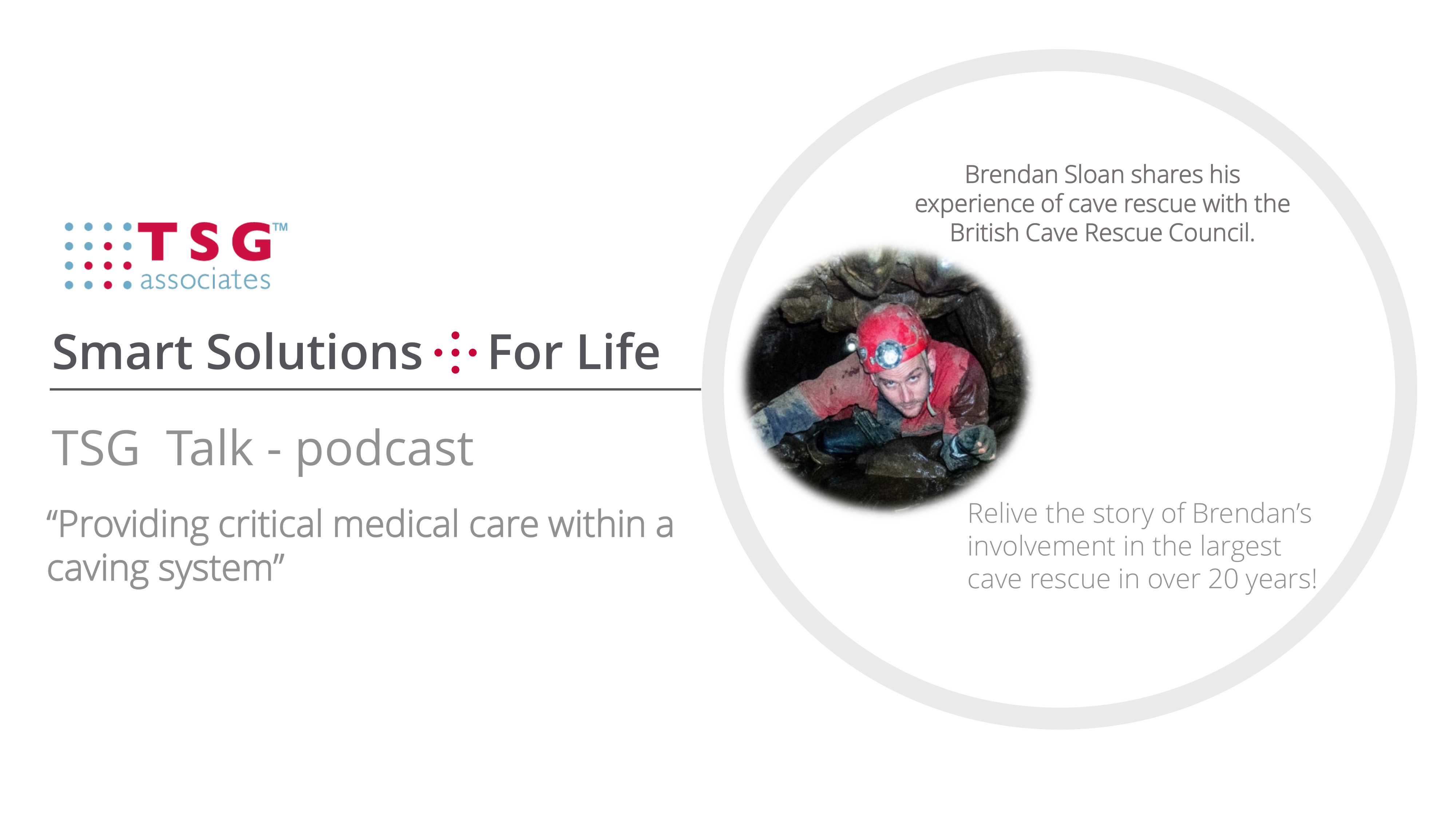


05/09/2022
TSG Talk - Providing medical care within a caving system
There are many complex environments in which medical care will need to be provided, and one of the most challenging is within a cave system in which countless issues could arise, from time to resources, as well as finding safe access for those looking to tend to the patient.
In a recent episode of our podcast, TSG Talk, Senior Partner, Colin Smart, discussed the unbelievable story of an injured caver being successfully rescued following a 54-hour cave rescue operation with Dr Brendan Sloan, from the British Cave Rescue Council.
What triggered the rescue operation?
On Saturday 6th November 2021, a caver set out on an expedition in the beautiful Ogof Ffynnon Ddu cave in South Wales with a team, the deepest cave in the United Kingdom, where a boulder fell underneath them causing the caver to also fall and sustain serious injuries including a broken jaw, broken ribs, and fractured lower leg.
“The boulders fell from underneath them and fell down with them about eight meters into a rift sustaining some pretty significant injuries. He did a pretty good job of damaging his face. He broke his jaw and had quite a significant hole in the – basically – in the bottom of his mouth, which everything was kind of dribbling out of. He broke a number of ribs and managed to rupture his spleen as well, which we found out later. He had quite a nasty fracture of his lower leg as well. But the position he was in at that point made it quite difficult for people to get down to him.”
What challenges did the rescue team face?
With any rescue operation, there are challenges to be faced to provide assistance as quickly and safely as possible. However, in this instance, there were a number of challenges that Dr Sloan and his team faced, including trying to find the quickest and safest route to the patient, as well as moving boulders obstructing their path to reach the patient.
“The area was really quite tight, quite awkward. The boulders that which had – obviously, which had been assumed as solid as people had walked on them before – obviously weren't anymore, so that provided some technical challenge in actually getting down to him. And then there was some quite restrictive passage to getting him back onto – kind of – onto the main route.
But the problem with the entrance that comes in is that the entrance that comes in is quite tight in places and there are quite a lot of boulders. There's quite a lot of squeezing between things which is fine when you're mobile, but it was pretty clear that he was going to be coming out in a stretcher pretty much from the outset. There was no way that he was going to be coming out of it that way.”
Due to the depth of the cave, the team had significantly further to travel than the average cave which played a factor in the time spent rescuing and caring for the patient as they realised, they would need to redirect their path to get the patient out effectively. The only way they found they would be able to do this, was by going through the top entrance instead which would add a sizeable number of kilometres to climb to reach safety, which, with an injured patient on a stretcher, was going to fair quite difficult.
“So, it’s significantly further to travel and although it is an easier passage, it's certainly not easy. So, there were a number of significant challenges: A pretty heavily injured guy, a fair way from the entrance, and some pretty challenging caving to do that as well. So, not the kind of thing that we have in our normal rescues."
Applying care in a caving system
When administering care within a caving system, it’s important to have a strong team that is capable of doing their part to minimise suffering for the patient as well as safely navigating them out of the cave for further treatment. Resources are limited, so the best alternative is to offer a degree of calmness and reassurance to the casualty so as not to draw alarm and risk their body further strain.
“There is a lot of stuff here which could be a problem and there is not a lot I can do about it underground. And often in these situations the thing that a doctor can bring is not necessarily lots of clever skills or tools because we don't have lots of stuff, we can use underground in these situations. But what we do have is experience and familiarity with it. So, most of what we could offer is a degree of calmness. It's difficult to be calm when we're being presented with something of that nature.”
There can often be times within caving systems when it can prove to be difficult to make progress in tending to a patient, so it’s important to understand the location and scenarios faced and be always thinking of different ways to handle the situation. Showing confidence and calmness, in otherwise nerving and sometimes terrifying situations, can make all the difference in getting the patient out of that incident securely.
“I took some ketamine down with me in case I needed to use it, which fortunately we didn't. But it was that kind of if we get to a position where we're having to do things which are really quite uncomfortable and it's a real struggle; having a plan as to how I can deal with that. Anaesthetists are always trying to work with plans – having a plan A, a plan B, a plan C, a plan D. And I was trying to formulate that, and although it is – it’s quite difficult and to some degree, you need to get down there and lay eyes on what's going on.”
Preparing for a rescue operation
Conducting a rescue operation in a caving system which involves providing medical care in dangerous environments, is a challenging situation to be a part of if you do not have the relevant caving experiences or skills to work in such conditions, and are not similar to the area you are in.
You need to understand what you’re getting involved with from the outset and know that you are fully prepared when tasked with safely redeeming, or even just talking, to the casualty from a dire accident so as not to unnerve your team, or most importantly, the patient.
“I mean, I think you need to understand the environment you're going into. Cave Rescue is pretty austere, but I wouldn't say that means I could go and work in a desert environment because that's not one I'm familiar with. There would be things that would be similar in terms of not having a lot of equipment – in terms of it being very challenging. And there are similarities, but you need to understand the environment you're going into, and you need to be at least to some degree comfortable in that before you can start being able to do decent medical care.”
When rescuing a casualty under such limited circumstances, you sometimes need to revert and think back to your clinical understanding of the basics of medical care, such as pain relief or stopping bleeding effectively, as it’s unlikely you’ll be able to provide any advanced care due to the lack of space or access to resources.
“Good clinical skills and doing the basics right, I think, is really important, because you may not be able to do much more than that, so you need to be able to do that. Because a lot of the time doing the basics right, whether that's pain relief, whether it's stopping bleeding, whether it's confidence, whether it's being able to make a decision about evacuation because actually, that's what needs to happen. And monitoring with very little other than your hands and your eyes – that will get you a really long way.”
What is your essential medical equipment?
Dr Sloan then explained why he would always have a casualty bag no matter where he was.
“I would take our casualty bag. I've been camping in the tropics where the underground temperature is 30°C, but anywhere in the UK, and to be honest, anywhere in Europe it's cold. Some of it's cold enough that you notice it's cold. Some of it’s ok, but when you stop moving you notice it. Hypothermia is the thing we really, really, really massively worry about. In other rescues stopping people getting cold makes a massive difference and gives you the chance of a casualty being mobile. And if you can keep them mobile, you've won. If you let them get cold and they get tired, you've lost it and you've made it a lot harder. So I would have something to manage hypothermia and I'd probably choose our casualty bag because we've got a nice new light effective one.”
Find out more
Click here to listen to the full TSG Talk episode featuring Dr Brendan Sloan, to find out more about life-saving solutions, please call TSG Associates on 01422 557841 or email us at info@tsgassociates.
If you want to learn more about the British Cave Rescue Council, click here to visit their website where you can also donate to your local cave rescue.



%202.png)






